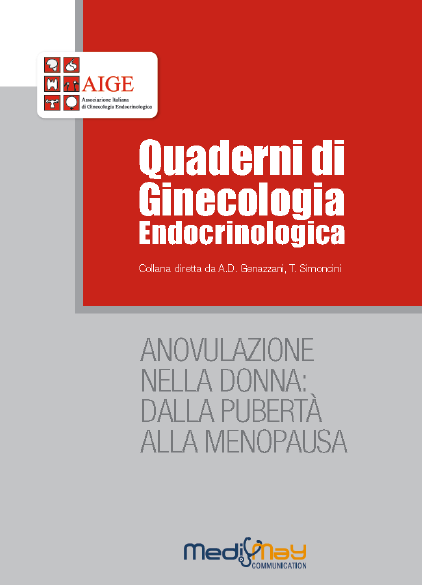-
Sebastião Freitas de Medeiros, Bruna Barcelo Barbosa, Ana Karine Lin Winck Yamamoto, Márcia Marly Winck Yamamoto, Matheus Antônio Souto de Medeiros, José Maria Soares Junior, Edmund Chada Baracat
The interplay between androgens and adipocytes: the foundation of comorbidities of polycystic ovary syndromeGynecological and Reproductive Endocrinology & Metabolism (2022)
DownloadAbstract
This review updates current knowledge of the relationship between androgens and adipocytes in women with polycystic ovary syndrome. Relevant studies published between 1983 and 2021 were examined. Adipocytes take up androgens, convert weak androgens into potent ones, and modulate the ovarian production of testosterone and androstenedione through the actions of various adipocytokines. Androgens also modulate adipocyte proliferation and differentiation, stimulate adipocytokine production, and promote visceral adipose tissue accumulation. Androgens induce hypertrophy and insulin resistance in adipocytes. Finally, androgens stimulate β-cell production and insulin release. Insulin, in turn, amplifies androgen production by ovarian theca cells and favors visceral fat deposition. Altogether, these conditions favor the development of future comorbidities such as type 2 diabetes mellitus, dyslipidemia, non-alcoholic fatty liver disease, metabolic syndrome, arterial hypertension, low-grade chronic inflammation, and cardiovascular disease.
-
Anna Kostrzak, Blazej Meczekalski, Agnieszka Podfigurna, Stefano Luisi
A revolution in contraception: new vaginal ring with progesterone and with segesterone acetate/ethinylestradiol, and combined oral contraception with estetrolEuropean Gynecology and Obstetrics. 2022; 4(1):11-17
DownloadAbstract
Contraception is an essential component of birth control. The purpose of contraception is to prevent fertilization or implantation of a fertilized egg. Perfect contraception should be safe, effective, reversible, easy to use, widely available, and available at low/reasonable price. The choice of contra-ceptive method depends on many factors, the most important being the patient’s wishes and acceptance. In the case of women with severe or chronic illnesses, or at high risk of adverse events, contraception should be carefully considered and the most appropriate method should be selected. Hormonal contraception is the use of progestogens only or progestogens in combination with estrogens.
The mechanism of the contraceptive effect of hormonal agents is complex, and it comprises the effect of preparations on the process of ovarian follicle maturation and ovulation, and their impact on the uterine mucosa, cervical mucus, and possibly on the contractility of the fallopian tubes.
Combined hormonal preparations vary greatly, both in their routes of administration and in their administration schedules. Oral contraceptive pills differ primarily in the type of progestogen used and in the ethinylestradiol dose.
A new vaginal ring with progesterone was developed for post-partum contraception. Segesterone acetate in combination with ethinylestradiol is becoming available in some parts of the world. Other novel options include combined oral contraception with estetrol and drospirenone.
In the following review, the advantages and disadvantages of the above methods of contraception are presented in order to familiarize readers with the latest methods of birth control. -
Alessandro D. Genazzani, Christian Battipaglia, Tabatha Petrillo, Nicola Piacquadio, Fedora Ambrosetti, Melania Arnesano, Elisa Semprini, Alessandra Sponzilli, Veronica Tomatis & Tommaso Simoncini
Familial diabetes predisposes PCOS patients to insulin resistance (IR), reproductive impairment and hepatic dysfunction: effects of d-chiro inositol (DCI) and alpha lipoic acid (ALA) administration on hepatic insulin extraction (HIE) indexGynecology Endocrinol. 24:1-8, 2022Abstract
Objective: PCOS is a syndrome is characterized by 2 out of 3 of the criteria established during the Rotterdam Consensus Conference. Recently the issue of insulin resistance (IR) has caught attention.
Subjects: A group of overweight/obese PCOS patients (n = 30) have been evaluated before and after 3 months of daily integrative administration of d-chiro inositol (DCI) (500 mg) and alpha lipoic acid (ALA) (300 mg).
Methods: Hormonal and metabolic profiles, oral glucose tolerance test (OGTT) for glucose, insulin and C-peptide response were performed in baseline conditions and after DCI plus ALA treatment. Hepatic Insulin Extraction (HIE) index was computed along the OGTT to evaluate the liver ability in degrading insulin.
Results: The treatment decreased LH, Androstenedione (A), insulin plasma levels, BMI, HOMA index, AST and ALT. Considering patients for the presence (n = 17) or absence of familial diabetes (n = 13), the greatest improvements occurred in the former patients. Insulin response to OGTT was greatly reduced after the treatment interval in PCOS with familial diabetes. HIE computation disclosed that in presence of familial diabetes liver degradation of insulin is reduced thus leaving a higher amount of circulating insulin. DCI plus ALA administration decreased AST and ALT and restored hepatic insulin clearance since HIE profile was improved.
Conclusion: Our study demonstrates that in overweight/obese PCOS the predisposition to familial diabetes triggers IR not only through the endogenous impaired DCI and ALA synthesis but also through a reduced hepatic clearance of insulin. DCI plus ALA administration positively improved hormonal, metabolic profiles as well as liver function. -
Anna Szeliga and Blazej Meczekalski
Kisspeptin Modulation of Reproductive FunctionEndocrines 2022, 3(3), 367-374
DownloadAbstract
Kisspeptin is a peptide expressed mainly in the infundibular nucleus of the hypothalamus. Kisspeptin plays a crucial role in the regulation of reproductive functions. It is regarded as the most important factor responsible for the control of the hypothalamic–pituitary–gonadal axis, the onset of puberty, and the regulation of menstruation and fertility. Kisspeptin activity influences numerous processes such as steroidogenesis, follicular maturation, ovulation, and ovarian senescence. The identification of kisspeptin receptor mutations that cause hypogonadotropic hypogonadism has initiated studies on the role of kisspeptin in puberty. Pathologies affecting the neurons secreting kisspeptin play a major role in the development of PCOS, functional hypothalamic amenorrhea, and perimenopausal vasomotor symptoms. Kisspeptin analogs (both agonists and antagonists), therefore, may be beneficial as therapy in those afflicted with such pathologies. The aim of this review is to summarize the influence of kisspeptin in the physiology and pathology of the reproductive system in humans, as well as its potential use in therapy.
-
Rossella E. Nappi, Laura Cucinella, David Bosoni, Alessandra Righi, Federica Battista, Pietro Molinaro, Giulia Stincardini, Manuela Piccinino, Roberta Rossini and Lara Tiranini
Premenstrual Syndrome and Premenstrual Dysphoric Disorder as Centrally Based DisordersEndocrines 2022, 3(1), 127-138
DownloadAbstract
Premenstrual syndrome (PMS) and premenstrual dysphoric disorder (PMDD) encompass a variety of symptoms that occur during the luteal phase of the menstrual cycle and impair daily life activities and relationships. Depending on the type and severity of physical, emotional or behavioral symptoms, women of reproductive age followed for at least two prospective menstrual cycles may receive one of the two diagnoses. PMDD is the most severe form of PMS, predominantly characterized by emotional and behavioral symptoms not due to another psychiatric disorder. PMS and PMDD are common neuro-hormonal gynecological disorders with a multifaceted etiology. Gonadal steroid hormones and their metabolites influence a plethora of biological systems involved in the occurrence of specific symptoms, but there is no doubt that PMS/PMDD are centrally based disorders. A more sensitive neuroendocrine threshold to cyclical variations of estrogens and progesterone under physiological and hormonal therapies is present. Moreover, altered brain sensitivity to allopregnanolone, a metabolite of progesterone produced after ovulation potentiating GABA activity, along with an impairment of opioid and serotoninergic systems, may justify the occurrence of emotional and behavioral symptoms. Even neuro-inflammation expressed via the GABAergic system is under investigation as an etiological factor of PMS/PMDD. Pharmacological management aims to stabilize hormonal fluctuations and to restore the neuroendocrine balance. The rationale of suppressing ovulation supports prescription of combined hormonal contraception (CHC). Its effect on mood is highly variable and depends on biochemical characteristics of exogenous steroids and on type and severity of symptoms. Hormonal regimens reducing the estrogen-free interval or suppressing menstruation seem better choices. Psychoactive agents, such as serotonin reuptake inhibitors (SSRIs), are effective in reducing the symptoms of PMS/PMDD and may be prescribed continuously or only during the luteal phase. Novel therapeutic approaches include inhibition of progesterone receptors in the brain, i.e., with ulipristal acetate, reduced conversion of progesterone with dutasteride, and modulation of the action of allopregnanolone on the brain GABAergic system with sepranolone.
-
Amelia K. Wesselink, Elizabeth E. Hatch, Kenneth J. Rothman, Tanran R. Wang, Mary D. Willis, Jennifer Yland, Holly M. Crowe, Ruth J. Geller, Sydney K. Willis, Rebecca B. Perkins, Annette K. Regan, Jessica Levinson, Ellen M. Mikkelsen, and Lauren A. Wise
A Prospective Cohort Study of COVID-19 Vaccination, SARS-CoV-2 Infection, and Fertility American Journal of Epidemiology, 191: 1383-1395, 2022Abstract
Some reproductive-aged individuals remain unvaccinated against coronavirus disease 2019 (COVID-19) because of concerns about potential adverse effects on fertility. Using data from an internet-based preconception cohort study, we examined the associations of COVID-19 vaccination and severe acute respiratory syndrome coronavirus 2 (SARS-CoV-2) infection with fertility among couples trying to conceive spontaneously. We enrolled 2,126 self-identified female participants aged 21–45 year residing in the United States or Canada during December 2020–September 2021 and followed them through November 2021. Participants completed questionnaires every 8 weeks on sociodemographics, lifestyle, medical factors, and partner information. We fit proportional probabilities regression models to estimate associations between self-reported COVID-19 vaccination and SARS-CoV-2 infection in both partners with fecundability (i.e., the per-cycle probability of conception), adjusting for potential confounders. COVID-19 vaccination was not appreciably associated with fecundability in either partner (female fecundability ratio (FR) = 1.08, 95% confidence interval (CI): 0.95, 1.23; male FR = 0.95, 95% CI: 0.83, 1.10). Female SARS-CoV-2 infection was not strongly associated with fecundability (FR = 1.07, 95% CI: 0.87, 1.31). Male infection was associated with a transient reduction in fecundability (for infection within 60 days, FR = 0.82, 95% CI: 0.47, 1.45; for infection after 60 days, FR = 1.16, 95% CI: 0.92, 1.47). These findings indicate that male SARS-CoV-2 infection may be associated with a short-term decline in fertility and that COVID-19 vaccination does not impair fertility in either partner.
Karen E. Elkind-Hirsch, Ph.D., Neil Chappell, M.D., Donna Shaler, B.S., John Storment, M.D. and Drake Bellanger, M.D.
Liraglutide 3 mg on weight, body composition, and hormonal and metabolic parameters in women with obesity and polycystic ovary syndrome: a randomized placebo-controlled-phase 3 studyFertility and Sterility 118 : 371-381, 2022
DownloadAbstract
Objective: To study the efficacy and safety of the GLP-1 analog liraglutide 3 mg (LIRA 3 mg) vs. placebo (PL) for reduction of body weight (BW) and hyperandrogenism in women with obesity and polycystic ovary syndrome (PCOS).
Design: Randomized, double-blind, placebo-controlled trial.
Setting: Hospital-based outpatient endocrine and metabolic center.
Patient(s): Women diagnosed with PCOS (NIH criteria) were randomly assigned to LIRA 3 mg (n ¼ 55) or PL (n ¼ 27) once daily for 32 weeks with lifestyle intervention.
Intervention(s): Study visits at baseline and 32 weeks included BW and body composition by dual-energy x-ray absorptiometry. Oral,glucose tolerance tests were done with sex steroids, free androgen index (FAI), and lipids measured in the fasting sample.
Main Outcome Measure(s): The primary end points were changes in BW and FAI. Safety was assessed in all patients who received at least one dose of the study drug.
Result(s): Change in BW from baseline to week 32 was 5.7% (0.75) with LIRA 3 mg vs. -1.4% (1.09) with PL. At week 32, more participants on LIRA 3 mg than on PL achieved at least 5% weight reductions (25 of 44 vs. 5 of 23). Free androgen index significantly reduced with LIRA 3 mg compared with the PL where the mean FAI slightly increased. Gastrointestinal events, which were mostly mild to moderate, were reported in 58.2% of the LIRA 3 mg-subjects and 18.5% of PL subjects.
Conclusion(s): LIRA 3 mg once daily appears superior to PL in reducing BW and androgenicity and improving cardiometabolic parameters in women with PCOS and obesity.Carmen Pingarrón Santofímia, Pilar Lafuente González, María del Carmen Guitiérrez Vélez, Virginia Calvente Aguilar, Silvia Poyo Torcal, Pablo Terol Sánchez &Santiago Palacios
Long-term use of ospemifene in clinical practice for vulvo-vaginal atrophy: end results at 12 months of follow-upGynecological Endocrinology, 38:7, 577-582, 2022Abstract
Objective: To assess the improvement in vulvovaginal atrophy (VVA) of postmenopausal women treated with oral ospemifene 60 mg/day under conditions of routine clinical practice after 12 months of follow-up.
Methods: The AYSEX study is a Spanish observational, prospective, and unicentric study in which five gynecologists recruited postmenopausal women with VVA in routine clinical practice treated with oral ospemifene 60 mg/day as an appropriate therapeutic option. Vaginal health, the most bothersome symptoms, sexual health, endometrial safety, bone resorption markers, bone densitometry, mammography, treatment satisfaction, and quality of life were assessed at baseline and after 12 months using appropriate scales.
Results: A total of 100 postmenopausal women cytologically and clinically diagnosed with VVA were included in the study. After 3 months of treatment with ospemifene, a significant improvement was observed in all domains of Vaginal Health Index. This improvement was maintained at month 12 and only one patient remained with vaginal atrophy. In addition, a significant improvement was observed in the most bothersome symptoms, sexual function, and quality of life. There was no significant change in endometrial thickness, mammography, and bone health during the 12 months of treatment.
Conclusions: This study in routine clinical practice conditions confirms the results previously reported by randomized controlled trials, including a significant improvement in VVA, sexual function, quality of life, endometrial safety, and satisfaction with the treatment.Qian Zhao & Jin He
Efficacy and safety of metformin in pregnant women with polycystic ovary syndrome: a systematic review with meta-analysis of randomized and non-randomized controlled trials Gynecological Endocrinology, 38:7, 558-568, 2022Abstract
Objective: To evaluate the efficacy and safety of using metformin in pregnant women with polycystic ovarian syndrome (PCOS) and to explore the most effective and safe protocol by using a meta-analysis method.
Methods: Medline, EMBASE, Cochrane Library, and other databases were searched for randomized controlled trials and prospective cohort studies enrolling pregnant women with PCOS on receiving metformin or placebo or nothing. Subgroup analyses were undertaken.
Results: A total of 17 studies involving 2899 patients were included. Compared with control group, the use of metformin significantly reduced the incidence of preterm delivery (cumulative rate 3.86% vs 9.19%, relative risk (RR), 0.42 [95% confidence interval (CI), 0.25–0.71,]; p = .001), early miscarriage (cumulative rate 6.58% vs 18.35%, RR, 0.40 [95% CI, 0.20–0.78]; p = .007), gestational diabetes (cumulative rate 12.86% vs 22.91%, RR, 0.48 [95% CI, 0.26–0.89]; p = .02), and pre-eclampsia (cumulative rate 4.95% vs 7.72%, RR, 0.61 [95% CI, 0.40–0.93]; p = .02), the need for insulin treatment throughout pregnancy (cumulative rate 2.14% vs 5.12%, RR, 0.43 [95% CI, 0.22–0.85]; p = .01), and weight gain of pregnant women (mean difference, −2.45, [95% CI, −3.04 to −1.85]; p < .00001). Conclusions: The use of metformin in pregnant women with PCOS can significantly reduce maternal complications. No significant difference was observed in serious maternal adverse events. The efficacy and safety of metformin are worthy of recognition.Shu Qin Wei, Marianne Bilodeau-Bertrand, Nathalie Auger
Association of PCOS with offspring morbidity: a longitudinal cohort study Human Reproduction 37: 2135-2142, 2022Abstract
STUDY QUESTION: Do children whose mothers have polycystic ovary syndrome (PCOS) have an increased risk of morbidity?
SUMMARY ANSWER: Maternal PCOS is associated with an increased risk of infection, allergy and other childhood morbidity.
WHAT IS KNOWN ALREADY: PCOS is associated with higher rates of gestational diabetes, pre-eclampsia and preterm delivery, but the long-term impact on child health is poorly understood.
STUDY DESIGN, SIZE, DURATION: We conducted a retrospective longitudinal cohort study of 1 038 375 children in Quebec between 2006 and 2020.
PARTICIPANTS/MATERIALS, SETTING, METHODS: We included 7160 children whose mothers had PCOS and 1 031 215 unexposed children. Outcomes included child hospitalization for infectious, allergic, malignant and other diseases before 13 years of age. We estimated hazard ratios (HRs) and 95% CI for the association of PCOS with childhood morbidity in adjusted Cox proportional hazards regression models.
MAIN RESULTS AND THE ROLE OF CHANCE: Children exposed to PCOS were hospitalized at a rate of 68.9 (95% CI 66.2–71.8) per 1000 person-years, whereas unexposed children were hospitalized at a rate of 45.3 (95% CI 45.1–45.5) per 1000 person-years. Compared with no exposure, maternal PCOS was associated with 1.32 times the risk of any childhood hospitalization (95% CI 1.26–1.40), 1.31 times the risk of infectious disease hospitalization (95% CI 1.25–1.38) and 1.47 times the risk of allergy-related hospitalization (95% CI 1.31–1.66). Risk of hospitalization was also elevated for childhood metabolic (HR 1.59, 95% CI 1.16–2.18), gastrointestinal (HR 1.72, 95% CI 1.53–1.92), central nervous system (HR 1.74, 95% CI 1.46–2.07) and otologic disorders (HR 1.34, 95% CI 1.26–1.43). Subgroup analyses suggested that there was little difference in the association of PCOS with hospitalization among boys (HR 1.31, 95% CI 1.24–1.39) and girls (HR 1.34, 95% CI 1.26–1.43).
LIMITATIONS, REASONS FOR CAUTION: We analyzed severe childhood morbidity requiring hospitalization, not mild diseases treated in ambulatory clinics. We lacked data on ethnicity, education and physical activity, and cannot rule out residual confounding.
WIDER IMPLICATIONS OF THE FINDINGS: Our findings suggest that maternal PCOS is associated with an increased risk of childhood morbidity.Marlene Hager, Johannes Ott, Julian Marschalek, Marie‑Louise Marschalek, Clemens Kinsky, Rodrig Marculescu and Didier Dewailly
Basal and dynamic relationships between serum anti-Müllerian hormone and gonadotropins in patients with functional hypothalamic amenorrhea, with or without polycystic ovarian morphology Reproductive Biology and Endocrinology (2022) 20: 98
DownloadAbstract
Background: To evaluate in women with functional hypothalamic amenorrhea (FHA), whether there is a difference between patients with and without polycystic ovarian morphology (PCOM) concerning the response to a gonadotropin releasing hormone (GnRH) stimulation test and to pulsatile GnRH treatment.
Methods: In a retrospective observational study, 64 women with FHA who underwent a GnRH stimulation test and 32 age-matched controls without PCOM were included. Pulsatile GnRH treatment was provided to 31 FHA patients and three-month follow-up data were available for 19 of these.
Results: Serum levels of gonadotropins and estradiol were lower in FHA women than in controls (p < 0.05). FHA patients revealed PCOM in 27/64 cases (42.2%). FHA patients without PCOM revealed lower anti-Müllerian hormone (AMH) levels than controls (median 2.03 ng/mL, IQR 1.40–2.50, versus 3.08 ng/mL, IQR 2.24–4.10, respectively, p < 0.001). Comparing FHA patients with and without PCOM, the latter revealed lower AMH levels, a lower median LH increase after the GnRH stimulation test (240.0%, IQR 186.4–370.0, versus 604.9%, IQR 360.0–1122.0; p < 0.001) as well as, contrary to patients with PCOM, a significant increase in AMH after three months of successful pulsatile GnRH treatment (median 1.69 ng/mL at baseline versus 2.02 ng/mL after three months of treatment; p = 0.002).
Conclusions: In women with FHA without PCOM, the phenomenon of low AMH levels seems to be based on relative gonadotropin deficiency rather than diminished ovarian reserve. AMH tended to rise after three months of pulsatile GnRH treatment. The differences found between patients with and without PCOM suggest the former the existence of some PCOS-specific systemic and/or intra-ovarian abnormalities.Krzysztof Nowosielski
Do oral combined contraceptive pills modify body image and sexual function? Reproductive Biology and Endocrinology (2022) 20:94
DownloadAbstract
Background: The effect of hormonal contraceptives on sexual function and body image is still controversial. Existing studies have not come to definite conclusions on the association between hormonal contraceptive use and sexual function/presence of sexual dysfunction or changes in body image perception. Thus, this study aimed to evaluate the prevalence of sexual problems/dysfunction in Polish women of reproductive age (18–45 years) and to assess to what extent oral combined contraceptive pills (OCCP) impact body image, sexual function and the prevalence of female sexual dysfunction (FSD).
Methods: A total of 495 women were included in this cross-sectional questionnaire-based study. Sexual function was assessed by the Changes in Sexual Function Questionnaire (CSFQ), the prevalence of FSD was assessed by DSM-5 criteria, and body image was assessed by the Body Exposure during Sexual Activity Questionnaire (BESAQ). A total of 237 women using OCCP were the study group (HC), and the rest were controls (CG). A regression model was used to evaluate the influence of the selected variables on sexual function and the presence of FSD.
Results: The prevalence of FSD was 7.5% in HC and 2.6% in CG, and 22% compared to 14% of women in HC and CG, respectively, reported sexual problems (CSFQ). The demographic characteristics of those using other contraception methods or not using any contraception (control group) were similar. The contraceptive group was characterized by significantly higher importance of sex (4.03 vs. 3.79), worse partner’s attitude toward sex (4.35 vs. 4.47), worse self-attitude toward sex (4.35 vs. 4.47), and worse body image (BESAQ) compared to controls. Among all of the variables, a lower level of anxiety (t = -1.99), positive attitudes toward sex (t = 2.05), watching erotic videos (t = 5.58) and a higher importance of sex (t = 5.66) were predictive of better sexual function (R2–0.38, F = 28.9, p = 0.0001).
Conclusion: Sexual behaviors and function are different in those using OCCP compared to nonusers. The prevalence of sexual problems and dysfunction was higher in those using this hormonal method of contraception; however, using OCCP was not a risk factor for either worse sexual function or sexual dysfunction. Partners’ attitudes toward sex and general anxiety level were factors contributing to sexual function and the risk of sexual dysfunction in the population of women of reproductive age and should be routinely evaluated in clinical practice, especially before prescribing hormonal contraceptives.I prossimi appuntamenti Aige
Le alterazioni del ciclo riproduttivo
Feb 12 2024–Jan 01 2026
- Corso
- Evento AIGE
La contraccezione come terapia
Feb 17 2025–Jan 01 2026
- Corso
- Evento AIGE
Piccole donne crescono, dall’infanzia all’età fertile
Nov 27–Nov 29 2026
Firenze, Italia- Corso
- Evento AIGE
Affrontare la Premenopausa e la Menopausa
Feb 01–Dec 16 2026
- Corso
- Evento AIGE
Abstracts selezionati
-
Sebastião Freitas de Medeiros, Bruna Barcelo Barbosa, Ana Karine Lin Winck Yamamoto, Márcia Marly Winck Yamamoto, Matheus Antônio Souto de Medeiros, José Maria Soares Junior, Edmund Chada Baracat
The interplay between androgens and adipocytes: the foundation of comorbidities of polycystic ovary syndromeGynecological and Reproductive Endocrinology & Metabolism (2022)
Download -
Anna Kostrzak, Blazej Meczekalski, Agnieszka Podfigurna, Stefano Luisi
A revolution in contraception: new vaginal ring with progesterone and with segesterone acetate/ethinylestradiol, and combined oral contraception with estetrolEuropean Gynecology and Obstetrics. 2022; 4(1):11-17
Download -
Alessandro D. Genazzani, Christian Battipaglia, Tabatha Petrillo, Nicola Piacquadio, Fedora Ambrosetti, Melania Arnesano, Elisa Semprini, Alessandra Sponzilli, Veronica Tomatis & Tommaso Simoncini
Familial diabetes predisposes PCOS patients to insulin resistance (IR), reproductive impairment and hepatic dysfunction: effects of d-chiro inositol (DCI) and alpha lipoic acid (ALA) administration on hepatic insulin extraction (HIE) indexGynecology Endocrinol. 24:1-8, 2022 -
Anna Szeliga and Blazej Meczekalski
Kisspeptin Modulation of Reproductive FunctionEndocrines 2022, 3(3), 367-374
Download -
Rossella E. Nappi, Laura Cucinella, David Bosoni, Alessandra Righi, Federica Battista, Pietro Molinaro, Giulia Stincardini, Manuela Piccinino, Roberta Rossini and Lara Tiranini
Premenstrual Syndrome and Premenstrual Dysphoric Disorder as Centrally Based DisordersEndocrines 2022, 3(1), 127-138
Download -
Amelia K. Wesselink, Elizabeth E. Hatch, Kenneth J. Rothman, Tanran R. Wang, Mary D. Willis, Jennifer Yland, Holly M. Crowe, Ruth J. Geller, Sydney K. Willis, Rebecca B. Perkins, Annette K. Regan, Jessica Levinson, Ellen M. Mikkelsen, and Lauren A. Wise
A Prospective Cohort Study of COVID-19 Vaccination, SARS-CoV-2 Infection, and Fertility American Journal of Epidemiology, 191: 1383-1395, 2022






